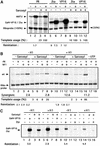Histone H1 enhances synergistic activation of the MMTV promoter in chromatin
- PMID: 12554659
- PMCID: PMC140736
- DOI: 10.1093/emboj/cdg052
Histone H1 enhances synergistic activation of the MMTV promoter in chromatin
Abstract
Minichromosomes assembled on the mouse mammary tumor virus (MMTV) promoter in vitro exhibit positioned nucleosomes, one of which covers the binding sites for progesterone receptor (PR) and nuclear factor 1 (NF1). Incorporation of histone H1 into MMTV minichromosomes improves the stability of this nucleosome and decreases basal transcription from the MMTV promoter, as well as its response to either PR or NF1. However, histone H1-containing minichromosomes display better PR binding and support a more efficient synergism between PR and NF1, leading to enhanced transcription initiation. A mutant MMTV promoter lacking positioned nucleosomes does not display enhanced transcriptional synergism in the presence of H1. Binding of PR leads to phosphorylation of H1, which leaves the promoter upon transcription initiation. Thus, H1 assumes a complex and dynamic role in the regulation of the MMTV promoter.
Figures








Similar articles
-
The mouse mammary tumour virus promoter positioned on a tetramer of histones H3 and H4 binds nuclear factor 1 and OTF1.J Mol Biol. 1998 May 15;278(4):725-39. doi: 10.1006/jmbi.1998.1718. J Mol Biol. 1998. PMID: 9614938
-
In vivo binding of proteins to stably integrated MMTV DNA in murine cell lines: occupancy of NFI and OTF1 binding sites in the absence and presence of glucocorticoids.Cell Mol Biol Res. 1994;40(7-8):643-52. Cell Mol Biol Res. 1994. PMID: 7787882
-
Histone acetylation characterizes chromatin presetting by NF1 and Oct1 and enhances glucocorticoid receptor binding to the MMTV promoter.Exp Cell Res. 2009 Sep 10;315(15):2604-15. doi: 10.1016/j.yexcr.2009.05.012. Epub 2009 May 20. Exp Cell Res. 2009. PMID: 19463811
-
Chromatin remodeling and control of cell proliferation by progestins via cross talk of progesterone receptor with the estrogen receptors and kinase signaling pathways.Ann N Y Acad Sci. 2006 Nov;1089:59-72. doi: 10.1196/annals.1386.025. Ann N Y Acad Sci. 2006. PMID: 17261755 Review.
-
Glucocorticoid receptor-mediated chromatin remodeling in vivo.Oncogene. 2001 May 28;20(24):3039-46. doi: 10.1038/sj.onc.1204328. Oncogene. 2001. PMID: 11420719 Review.
Cited by
-
Histone H1 Post-Translational Modifications: Update and Future Perspectives.Int J Mol Sci. 2020 Aug 18;21(16):5941. doi: 10.3390/ijms21165941. Int J Mol Sci. 2020. PMID: 32824860 Free PMC article. Review.
-
Mechanism of histone H1-stimulated glucocorticoid receptor DNA binding in vivo.Mol Cell Biol. 2007 Mar;27(6):2398-410. doi: 10.1128/MCB.01509-06. Epub 2007 Jan 8. Mol Cell Biol. 2007. PMID: 17210632 Free PMC article.
-
Four enzymes cooperate to displace histone H1 during the first minute of hormonal gene activation.Genes Dev. 2011 Apr 15;25(8):845-62. doi: 10.1101/gad.621811. Epub 2011 Mar 29. Genes Dev. 2011. PMID: 21447625 Free PMC article.
-
The H1 linker histones: multifunctional proteins beyond the nucleosomal core particle.EMBO Rep. 2015 Nov;16(11):1439-53. doi: 10.15252/embr.201540749. Epub 2015 Oct 15. EMBO Rep. 2015. PMID: 26474902 Free PMC article. Review.
-
Developmentally regulated linker histone H1c promotes heterochromatin condensation and mediates structural integrity of rod photoreceptors in mouse retina.J Biol Chem. 2013 Jun 14;288(24):17895-907. doi: 10.1074/jbc.M113.452144. Epub 2013 May 3. J Biol Chem. 2013. PMID: 23645681 Free PMC article.
References
-
- Banks G.C., Deterding,L.J., Tomer,K.B. and Archer,T.K. (2001) Hormone-mediated dephosphorylation of specific histone H1 isoforms. J. Biol. Chem., 276, 36467–36473. - PubMed
-
- Bonte E. and Becker,P.B. (1999) Preparation of chromatin assembly extracts from preblastoderm Drosophila embryos. Methods Mol. Biol., 119, 187–194. - PubMed
-
- Bouvet P., Dimitrov,S. and Wolffe,A.P. (1994) Specific regulation of Xenopus chromosomal 5S rRNA gene transcription in vivo by histone H1. Genes Dev., 8, 1147–1159. - PubMed
Publication types
MeSH terms
Substances
LinkOut - more resources
Full Text Sources
Other Literature Sources
Molecular Biology Databases
Research Materials
Miscellaneous

